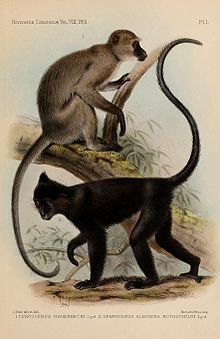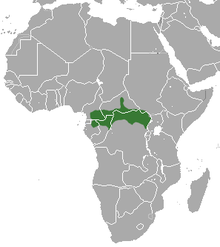- Agile mangabey
-
Agile mangabey[1] 
Agile mangabey, on the top Conservation status Scientific classification Kingdom: Animalia Phylum: Chordata Class: Mammalia Order: Primates Family: Cercopithecidae Genus: Cercocebus Species: C. agilis Binomial name Cercocebus agilis
(Milne-Edwards, 1886)
Agile mangabey range The agile mangabey (Cercocebus agilis) is an Old World monkey of the white-eyelid mangabey group found in swampy forests of Central Africa in Equatorial Guinea, Cameroon, Gabon, Central African Republic, Republic of Congo, and DR Congo.[1] Until 1978, it was considered a subspecies of the Tana River mangabey (C. galeritus).[3] More recently, the golden-bellied mangabey (C. chrysogaster) has been considered a separate species instead of a subspecies of the agile mangabey.[1]
Contents
Physical characteristics
The agile mangabey has a short, overall dull olive-grey pelage.[4] The bare skin of the face and feet is blackish.[5] Males are 51–65 centimeters (20–26 in) in length and weigh about 7–13 kilograms (15–29 lb), while the smaller females are 44–55 centimeters (17–22 in) and weigh 5–7 kilograms (11–15 lb).[4]
Behavior
Similar to other mangabeys, they are diurnal.[3] Although generally arboreal, they do spend a significant portion of their time (12–22%) on the ground,[5] especially during the dry season. It is typically more commonly heard than seen,[4] and males have a loud, species-specific call that is believed to be used to space themselves out.[3] Other calls are also used to maintain group cohesion and warn of predators.[5] Group size can be as high as 18 members, led by a single adult male. Group meetings can be friendly and may involve exchange of members. Adult males not in groups often travel singly.[4]
Diet
Fruit makes up a major portion of the agile mangabey diet. They are known to eat at least 42 different species of fruit.[5] Their tooth structure and powerful jaws allows them to open tough pods and fruits that many other monkeys can not access.[5] Agile mangabeys eat from a number of dominant swamp-forest trees, including dika nuts and sugar plums, when they are fruiting.[4] They also eat fresh leaf shoots from raffia palms when fruits are scarce. Grasses and mushrooms,[4] as well as insects, other invertebrates, bird's eggs and some vertebrate prey, such as rodents, are also eaten.[5]
Other
Agile mangabeys are known to contract T-cell leukemia virus, similar to the leukemia virus that infects humans.[6] There is also evidence that they contract Simian immunodeficiency virus (SIV), a virus related to human HIV that infects certain apes and monkeys.[7] They have rarely been kept in captivity,[5] with only three individuals held in ISIS registered institutions in July 2008.[8]
References
- ^ a b c Groves, C. (2005). Wilson, D. E., & Reeder, D. M, eds. ed. Mammal Species of the World (3rd ed.). Baltimore: Johns Hopkins University Press. pp. 153. OCLC 62265494. ISBN 0-801-88221-4. http://www.bucknell.edu/msw3/browse.asp?id=12100426.
- ^ Hart, J., Butynski, T. M. & Kingdon, J. (2008). Cercocebus agilis. In: IUCN 2008. IUCN Red List of Threatened Species. Downloaded on 4 January 2009.
- ^ a b c Rowe, Noel (1996). The Pictorial Guide to the Living Primates. p. 144. ISBN 0-9648825-0-7.
- ^ a b c d e f Kingdon, Jonathan (1997). The Kingdon Field Guide to African Mammals. p. 44. ISBN 0-12-408355-2.
- ^ a b c d e f g "Agile Mangabey - Mangabey Species Survival Plan". http://www.mangabeyssp.org/Agile%20Mangabey.htm. Retrieved 2008-07-19.
- ^ "Simian T-Cell Leukemia Virus (STLV) Infection in Wild Primate Populations in Cameroon: Evidence for Dual STLV Type 1 and Type 3 Infection in Agile Mangabeys (Cercocebus agilis)". http://jvi.asm.org/cgi/content/full/78/9/4700. Retrieved 2008-07-09.
- ^ "Risk to Human Health from a Plethora of Simian Immunodeficiency Viruses in Primate Bushmeat". http://www.cdc.gov/ncidod/EID/vol8no5/01-0522.htm. Retrieved 2008-07-09.
- ^ "Cercocebus agilis agilis - International Species Information System Abstract". http://app.isis.org/abstracts/Abs70392.asp#2.0. Retrieved 2008-07-19.
Categories:- IUCN Red List least concern species
- Mammals of Africa
- Cercopithecine monkeys
- Animals described in 1886
Wikimedia Foundation. 2010.

